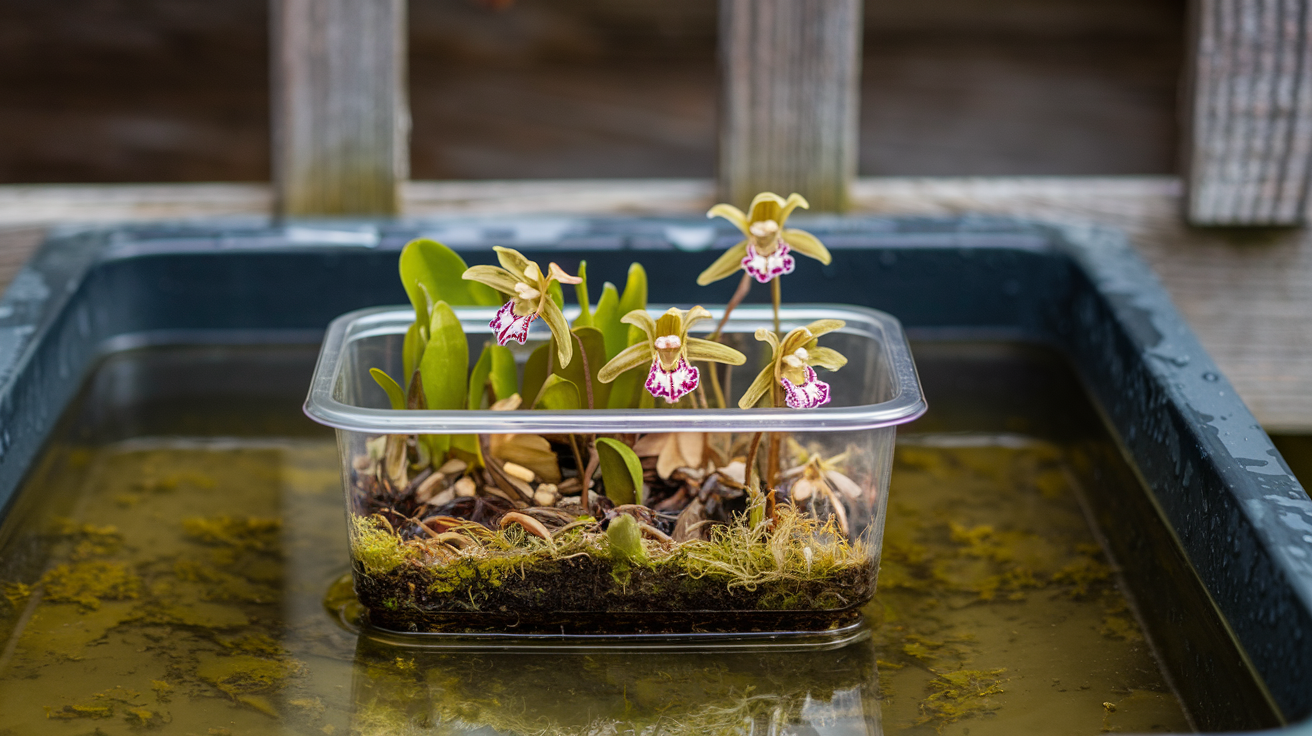Germinating orchid seeds is a delicate process that requires patience and precision. In this guide, Rhys Garden will walk you through the essential steps to successfully germinate orchid seeds and start your journey toward growing these beautiful plants from scratch.
Understanding Orchid Seeds
Before we dive into the germination process, it’s crucial to understand the unique nature of orchid seeds. Unlike many other plant seeds, orchid seeds are incredibly tiny and dust-like, often resembling fine powder to the naked eye. This microscopic size is both a blessing and a challenge for orchid enthusiasts.
The Fascinating World of Orchid Seeds
Orchid seeds are among the smallest in the plant kingdom, with some species producing seeds as small as 0.05 mm in length. To put this into perspective, a single orchid seed pod can contain millions of seeds! This evolutionary strategy allows orchids to disperse their seeds widely, increasing their chances of finding suitable growing conditions in their natural habitats.
Why Orchid Seeds Are Different
Unlike most plant seeds, orchid seeds lack an endosperm, the nutritive tissue that typically provides food for the developing embryo. This unique characteristic means that orchid seeds require specific conditions and symbiotic relationships to germinate and grow successfully in the wild.
The Natural Germination Process: A Delicate Dance with Fungi

In their natural habitats, orchid seeds rely on a fascinating symbiotic relationship with specific fungi to germinate and grow. This process, known as mycorrhizal association, is crucial for the seed’s survival and development.
The Role of Mycorrhizal Fungi
When an orchid seed lands on a suitable substrate in the wild, it must encounter the right type of fungus to begin its growth journey. The fungus penetrates the seed coat and forms a symbiotic relationship with the developing embryo, providing essential nutrients and helping to break down organic matter in the environment.
Replicating Nature’s Process
While this natural process is beautiful in its complexity, it poses significant challenges for cultivators looking to germinate orchid seeds at home or in controlled environments. Fortunately, horticultural science has developed methods to replicate these conditions and improve germination rates dramatically.
Modern Techniques for Orchid Seed Germination
Thanks to advances in plant science and micropropagation techniques, orchid enthusiasts and professional growers now have several methods at their disposal to germinate these delicate seeds successfully.
Flasking: The Sterile Approach
One of the most popular and effective methods for germinating orchid seeds is known as flasking. This technique involves creating a sterile, nutrient-rich environment that mimics the symbiotic relationship found in nature.
Steps for Flasking Orchid Seeds:
- Seed Sterilization: The first crucial step is to sterilize the orchid seeds to prevent any contamination that could hinder germination. This is typically done using a dilute bleach solution or hydrogen peroxide.
- Preparing the Growth Medium: A specialized agar-based medium is prepared, containing essential nutrients, vitamins, and sometimes hormones to support seed germination and early growth. This medium is sterilized to ensure a contaminant-free environment.
- Sowing the Seeds: The sterilized seeds are carefully sown onto the prepared medium in sterile glass flasks or containers. This process requires a steady hand and is often done under a laminar flow hood to maintain sterility.
- Incubation: The flasks are sealed and placed in a controlled environment with appropriate light and temperature conditions. For many orchid species, temperatures between 70-80°F (21-27°C) and 12-16 hours of indirect light per day are ideal.
- Monitoring and Subculturing: As the seeds germinate and develop into protocorms (the earliest stage of orchid seedling development), they may need to be transferred to fresh medium to ensure continued growth. This process, known as subculturing, is typically done every few months.
The Symbiotic Method: Embracing Nature’s Way
For those who prefer a more natural approach or are working with species that are particularly challenging to germinate using sterile techniques, the symbiotic method offers an alternative.
Implementing the Symbiotic Method:
- Collecting Fungal Samples: This involves obtaining samples of mycorrhizal fungi from the roots of mature orchids of the same or related species.
- Preparing a Natural Substrate: A mix of organic materials such as finely ground bark, sphagnum moss, and sometimes leaf litter is prepared to mimic the orchid’s natural growing environment.
- Introducing the Fungi: The collected fungal samples are introduced to the substrate, allowing them to colonize the medium.
- Sowing the Seeds: Orchid seeds are sown onto the fungus-inoculated substrate.
- Maintaining Optimal Conditions: The setup is kept in a controlled environment with high humidity and appropriate temperature for the specific orchid species.
While this method can be more challenging and less predictable than flasking, it can yield excellent results for certain species and provides a fascinating glimpse into the natural germination process.
Common Challenges in Orchid Seed Germination
Even with modern techniques, germinating orchid seeds can present several challenges. Being aware of these potential hurdles can help you navigate the process more successfully.
Contamination: The Silent Killer
One of the biggest threats to successful orchid seed germination is contamination by unwanted fungi or bacteria. This is particularly problematic in sterile flasking techniques, where a single contaminant can quickly overrun the entire culture.
Prevention Tips:
- Always use sterile equipment and work in a clean environment.
- Consider using a laminar flow hood or DIY clean box for sowing seeds.
- Properly sterilize seeds and all materials used in the germination process.
Slow Growth and Development
Orchid seeds are notoriously slow to germinate and develop compared to many other plants. It’s not uncommon for seeds to take several weeks or even months to show signs of germination.
Patience is Key:
- Maintain consistent environmental conditions throughout the germination period.
- Resist the urge to frequently check or disturb the seeds, as this can introduce contaminants.
- Keep detailed records of sowing dates and conditions to track progress over time.
Specific Light and Temperature Requirements
Different orchid species have evolved to thrive in various environments, from tropical rainforests to alpine meadows. As such, they may have very specific light and temperature requirements for optimal germination.
Research and Adapt:
- Research the natural habitat of the orchid species you’re working with.
- Invest in adjustable grow lights and temperature control systems to provide ideal conditions.
- Monitor and adjust conditions based on the seedlings’ response.
Advanced Techniques for Experienced Growers
For those who have mastered the basics of orchid seed germination and are looking to take their skills to the next level, there are several advanced techniques to explore.
Cryopreservation: Preserving Genetic Diversity
Cryopreservation involves freezing orchid seeds or tissues in liquid nitrogen for long-term storage. This technique is invaluable for conserving rare species and maintaining genetic diversity in orchid populations.
Key Aspects of Cryopreservation:
- Seed Preparation: Seeds are carefully dehydrated to remove excess moisture without damaging the embryo.
- Protective Agents: Special cryoprotectants are often used to prevent ice crystal formation during freezing.
- Rapid Freezing: Seeds are plunged into liquid nitrogen, bringing them to temperatures around -196°C (-320°F).
- Long-term Storage: Properly stored seeds can remain viable for decades or even centuries.
- Thawing and Germination: When needed, seeds are carefully thawed and germinated using standard techniques.
In Vitro Breeding: Pushing the Boundaries of Orchid Genetics
For those interested in orchid hybridization and breeding, in vitro techniques offer exciting possibilities for creating new and unique orchid varieties.
Exploring In Vitro Breeding:
- Embryo Rescue: This technique allows for the cultivation of seeds from crosses that might not survive naturally, expanding the possibilities for new hybrids.
- Polyploidy Induction: By treating seedlings with chemicals like colchicine, it’s possible to create plants with multiple sets of chromosomes, often resulting in larger flowers or more robust plants.
- Somaclonal Variation: Through repeated subculturing of orchid tissues in vitro, growers can sometimes induce genetic variations that lead to new traits.
The Rewards of Patience: From Seed to Bloom
Germinating orchid seeds is undoubtedly a test of patience and dedication. It can take anywhere from 3 to 8 years for an orchid grown from seed to produce its first bloom, depending on the species. However, the rewards of this long journey are immeasurable.
The Joy of First Blooms
There’s nothing quite like the excitement of seeing the first flower bud appear on an orchid you’ve nurtured from seed. It’s a moment that encapsulates years of care, attention, and horticultural skill.
Contributing to Conservation
By learning to germinate orchid seeds successfully, you’re not just indulging in a fascinating hobby; you’re also contributing to the conservation of these incredible plants. Many orchid species are threatened in the wild due to habitat loss and over-collection. By cultivating orchids from seed, we can help reduce pressure on wild populations and potentially contribute to reintroduction efforts.
A Deeper Appreciation for Nature’s Complexity
The process of germinating orchid seeds offers a unique window into the intricate relationships between plants and their environments. It fosters a deeper appreciation for the complexity of nature and the delicate balance that sustains biodiversity on our planet.
Essential Tools and Equipment for Orchid Seed Germination
To increase your chances of success in germinating orchid seeds, having the right tools and equipment is crucial. Here’s a list of essential items that can help you create the optimal environment for your tiny orchid seeds to thrive:
Laminar Flow Hood or Clean Box
A laminar flow hood provides a sterile workspace by creating a constant flow of filtered air. This is essential for preventing contamination during the seed sowing process. For hobbyists, a DIY clean box can be a more affordable alternative, though it may not provide the same level of sterility.
Pressure Cooker or Autoclave
These are used to sterilize growth media, containers, and tools. A household pressure cooker can suffice for small-scale operations, while larger setups might require a dedicated autoclave.
Sterile Containers
Glass or plastic containers with airtight lids are necessary for creating a sealed environment for seed germination. Mason jars or specialized culture flasks are popular choices.
Growth Medium
Specialized agar-based media containing essential nutrients are crucial for seed germination. These can be purchased pre-made or mixed from individual components for more advanced growers.
Fine Tweezers and Scalpels
These tools are used for handling seeds and young seedlings during sowing and subculturing. Ensure they can be properly sterilized before each use.
Microscope or Magnifying Glass
Given the minute size of orchid seeds, a good quality microscope or strong magnifying glass is invaluable for inspecting seeds and monitoring early growth stages.
pH Meter
Maintaining the correct pH in your growth medium is crucial for successful germination. A reliable pH meter helps ensure your medium is within the optimal range for orchid seed growth.
Grow Lights
While not always necessary in the earliest stages of germination, appropriate lighting becomes crucial as protocorms develop. LED grow lights with adjustable spectrum and intensity are ideal for providing the right amount of light at each growth stage.
Temperature and Humidity Control
A stable environment is key to successful germination. Consider investing in a small grow tent or cabinet where you can closely control temperature and humidity levels.
Record-Keeping Materials
Detailed records of your germination attempts, including dates, species, media compositions, and environmental conditions, are invaluable for refining your technique over time. A dedicated notebook or digital spreadsheet can help you track your progress and learn from each attempt.
Conclusion
By following the proper techniques, you can successfully germinate orchid seeds and enjoy the rewarding experience of nurturing these stunning plants from the very beginning. With time and care, your orchids will thrive and bring beauty to your garden.

Related Posts
How to Germinate Lettuce Seeds: A Comprehensive Guide
The Ultimate Guide to Worms in Plant Soil: Friend or Foe?
Perennial Herbs for Zone 5: A Thriving Garden Year After Year